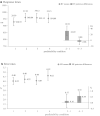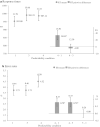Time-based task expectancy: perceptual task indicator expectancy or expectancy of post-perceptual task components?
- PMID: 34783896
- PMCID: PMC9177471
- DOI: 10.1007/s00426-021-01588-1
Time-based task expectancy: perceptual task indicator expectancy or expectancy of post-perceptual task components?
Abstract
The temporal predictability of upcoming events plays a crucial role in the adjustment of anticipatory cognitive control in multitasking. Previous research has demonstrated that task switching performance improved if tasks were validly predictable by a pre-target interval. Hence, far, the underlying cognitive processes of time-based task expectancy in task switching have not been clearly defined. The present study investigated whether the effect of time-based expectancy is due to expectancy of post-perceptual task components or rather due to facilitation of perceptual visual processing of the coloured task indicator. Participants performed two numeric judgment tasks (parity vs. magnitude), which were each indicated by two different colours. Each task was either more or less frequently preceded by one of two intervals (500 ms or 1500 ms). Tasks were indicated either by colours that were each more frequently (or in Exp. 1 also less frequently) paired with the interval or by colours that were equally frequent for each interval. Participants only responded faster when colour and task were predictable by time (expected colour), not when the task alone was predictable (neutral colour). Hence, our results speak in favour of perceptual time-based task indicator expectancy being the underlying cognitive mechanism of time-based expectancy in the task switching paradigm.
Keywords: Foreperiod; Task switching; Temporal preparation; Time-based expectancy.
© 2021. The Author(s).
Conflict of interest statement
All authors declare that there is no conflict of interest.
Figures




Similar articles
-
Only time will tell the future: Anticipatory saccades reveal the temporal dynamics of time-based location and task expectancy.J Exp Psychol Hum Percept Perform. 2020 Oct;46(10):1183-1200. doi: 10.1037/xhp0000850. Epub 2020 Jul 2. J Exp Psychol Hum Percept Perform. 2020. PMID: 32614216
-
Humans derive task expectancies from sub-second and supra-second interval durations.Psychol Res. 2020 Jul;84(5):1333-1345. doi: 10.1007/s00426-019-01155-9. Epub 2019 Feb 25. Psychol Res. 2020. PMID: 30805704
-
Time-Based Transition Expectancy in Task Switching: Do We Need to Know the Task to Switch to?J Cogn. 2021 Mar 10;4(1):19. doi: 10.5334/joc.145. J Cogn. 2021. PMID: 33748664 Free PMC article.
-
Transfer of time-based task expectancy across different timing environments.Psychol Res. 2018 Jan;82(1):230-243. doi: 10.1007/s00426-017-0895-1. Epub 2017 Jul 24. Psychol Res. 2018. PMID: 28741028
-
Dissociating strategy-dependent and independent components in task preparation.Neuropsychologia. 2014 Sep;62:331-40. doi: 10.1016/j.neuropsychologia.2014.04.015. Epub 2014 Apr 30. Neuropsychologia. 2014. PMID: 24791708 Review.
References
MeSH terms
Grants and funding
LinkOut - more resources
Full Text Sources

